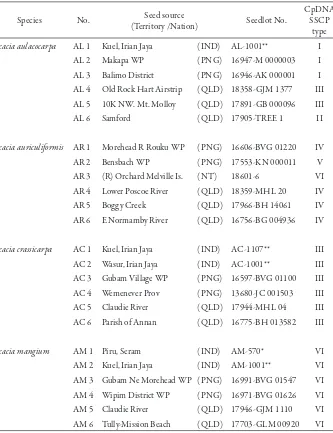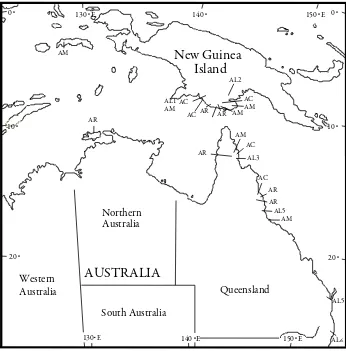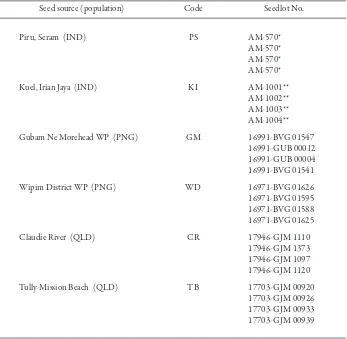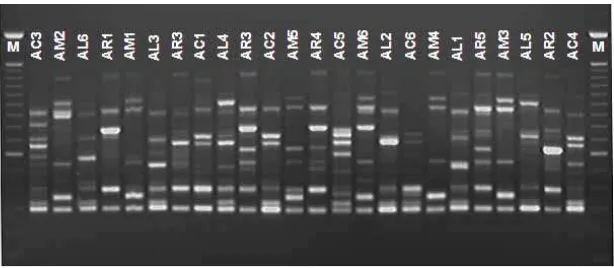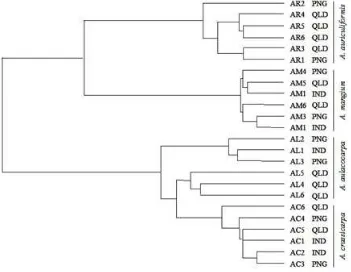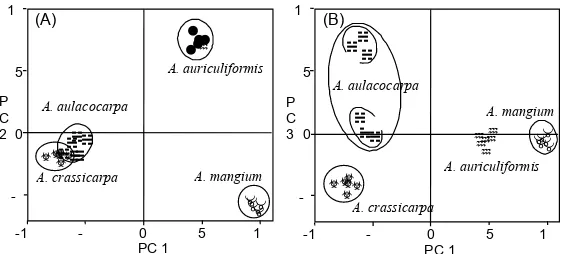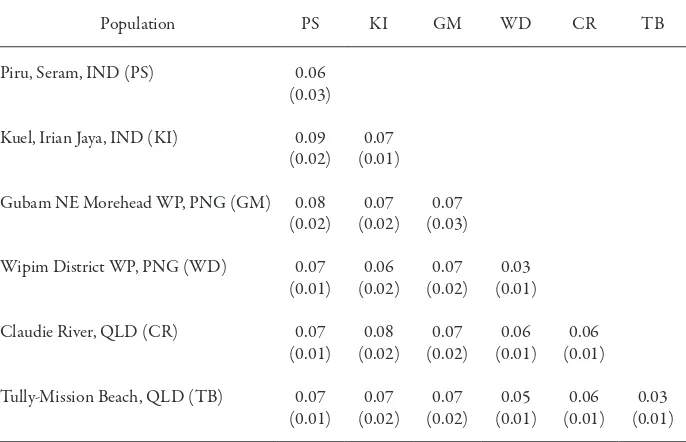MARKER
125-143Anthonius Y.P.B.C. Widyatmoko1,2, Atsushi Watanabe3, and Susumu Shiraishi4
ABSTRACT
Genetic diversity and relationship of four Acacia species, Acacia aulacocarpa, A.Cunn. ex Benth., A. auriculiformis Cunn. ex Benth., A. crassicarpa Cunn. exBenth. and A. mangium Willd. were investigated using DNA molecular markers. Using RAPD analysis, a total of 20 arbitrary primers successfully gave 127 polymorphic fragments. hese RAPD data were used to estimate genetic distance and construct dendrograms using the unweighted pair-group with the arithmetic mean average (UPGMA) method. he four species were divided into two major clusters. A. auriculiformis and A. mangium were in one cluster, and the other cluster contained both A. aulacocarpa and A. crassicarpa. he divergence time of the two species (A. auriculiformis and A. mangium) in the former cluster appeared to be relatively early in comparison to in the latter (A. aulacocarpa and A. crassicarpa) based on RAPD data. his result was also supported by Principal Component Analysis (PCA). Among the four species, A. aulacocarpa showed the highest divergence in nuclear DNA (ncDNA), followed by A. auriculiformis. SSCP analysis also revealed that these two species possessed a haplotypic variation of the trnL-trnF intergenic spacer region of chloroplast DNA. In A. aulacocarpa, a large diference in the composition of both nuclear and chloroplast genomes was observed between populations distributed in Queensland, Australia and those in New Guinea Island. In contrast, compared to the other species, A. mangium showed the lowest genetic diversity and less genetic diferentiation among populations.
Keywords:Acacia, genetic variation, phylogeny, RAPD, SSCP
I. INTRODUCTION
he genus Acacia is the largest genus of subfamily Mimosoideae, family Leguminosae. It includes over 1,200 species widely distributed in the Southern hemisphere, extending from South America and Australia to Africa (Ross, 1981; Brain and Maslin, 1996; Harrier et al., 1997). he most species-divergence of this genus occurs in Australia where there are approximately 650 species distributed across the continent (Pettigrew and Watson, 1975; Ross, 1981; Boughton, 1986).
1 Center for Forest Biotechnology and Tree Improvement Research, Jl. Palagan Tentara Pelajar Km.15,
Purwobinangun, Pakem, Sleman, Yogyakarta, Indonesia.
2 Corresponding Author. E-mail: aviwicaksono@yahoo.com 3 Forest Tree Breeding Center, Ibaraki, Japan
Acacia auriculiformis A. Cunn. ex Benth. and A. mangium Willd., which belong to section Julilorae (Benth.) Maiden & Betche in the subgenus Phyllodineae Benth., are naturally distributed throughout Australia, New Guinea Island, Aru Island, and Sula Island. hese species have been introduced as multiple-purpose species for plantation in tropical and subtropical areas around the world. In Southeast Asia, more than 500,000 ha of A. mangium plantations have been established for pulp and paper production (Butcher et al., 1998). Likewise, in Zaire, the plantations of A. auriculiformis and A. mangium play an important role in providing suicient fuel wood (Khasa, 1994). In Indonesia, A. mangium is the one of the major fast growing species used in plantation forestry program. A. crassicarpa is also become an important fast growing species for plantation in peat land.
Studies of the genetic diversity of the Acacia species have been reported by a number of authors. he genetic diversity of both A. auriculiformis and A. mangium has been assessed using isozyme analysis (Moran et al., 1988, 1989; Wickneswari and Norwati, 1993; Khasa, 1993, 1994). Moran et al. (1988) compared the genetic diversity of nine Acacia species based on isozyme analysis. he genetic diversity of A. mangium has also been studied using RFLP (restriction fragment length polymorphism) markers (Butcher et al., 1998).
Studies of the taxonomy and phylogeny of genus Acacia have been reported based on biochemistry and DNA molecular markers. Due to a serological investigation, Brain and Maslin (1996) have estimated the classiication of 48 species of subgenus Phyllodineae, predominantly distributed in Australia. In addition, Harrier et al. (1997) have performed RAPD (random ampliied polymorphic DNA) analysis to assess the phylogenetic relationship of African Acacia species.
polymorphism) analysis of chloroplast DNA. Further, we preliminarily estimated the genetic diversity of the four Acacia species.
II. MATERIALS AND METHODS
A. Plant materials and DNA extraction
Seeds of the four species were obtained from the Australian Tree Seed Centre of CSIRO (Commonwealth Scientiic and Industrial Research Organization), Australia and Forest Tree Improvement Research and Development Institute, Indonesia.
In order to elucidate the phylogeny among the four species and their genetic diversity, six seeds per species were used (Table 1). For A. aulacocarpa, one seed from Indonesia (IND), two from Papua New Guinea (PNG), and three from Queensland (QLD) were used. For A. auriculiformis, two seeds from PNG, three from QLD, and one from the Northern Territory (NT) were used. For A. crassicarpa and A. mangium, two seeds were used for each region (IND, PNG and QLD). hese samples represented the natural distribution of each species. he approximate location of each sample of the four species is shown in Figure 1.
To examine the genetic diversity of A. mangium in more detail, seed samples were further added from two populations in IND, PNG, and QLD, respectively (Table 2). Except for Piru of the Ceram Island, four seeds of diferent seedlots were used for each population. For Piru, four seeds from one bulk seedlot were used.
Total genomic DNA was extracted using a modiied CTAB protocol reported by Shiraishi and Watanabe (1995). he DNA was puriied using GENECLEAN III (BIO101) as a template for further analyses.
B. RAPD analysis
Table 1. Details of samples of four Acacia species and their cpDNA haplotypes
Species No. (Territory /Nation)Seed source Seedlot No.
CpDNA SSCP
type
Acacia aulacocarpa AL 1 Kuel, Irian Jaya (IND) AL-1001** I AL 2 Makapa WP (PNG) 16947-M 0000003 I AL 3 Balimo District (PNG) 16946-AK 000001 I AL 4 Old Rock Hart Airstrip (QLD) 18358-GJM 1377 III AL 5 10K NW. Mt. Molloy (QLD) 17891-GB 000096 III AL 6 Samford (QLD) 17905-TREE 1 II
Acacia auriculiformis AR 1 Morehead R Rouku WP (PNG) 16606-BVG 01220 IV AR 2 Bensbach WP (PNG) 17553-KN 000011 V AR 3 (R) Orchard Melville Is. (NT) 18601-6 VI AR 4 Lower Poscoe River (QLD) 18359-MHL 20 IV AR 5 Boggy Creek (QLD) 17966-BH 14061 IV AR 6 E Normamby River (QLD) 16756-BG 004936 IV
Acacia crassicarpa AC 1 Kuel, Irian Jaya (IND) AC-1107** III AC 2 Wasur, Irian Jaya (IND) AC-1001** III AC 3 Gubam Village WP (PNG) 16597-BVG 01100 III AC 4 Wemenever Prov (PNG) 13680-JC 001503 III AC 5 Claudie River (QLD) 17944-MHL 04 III AC 6 Parish of Annan (QLD) 16775-BH 013582 III
130・E 140・E 150・E
130・E 140・ 150・E 0・
20・
0・
20・
New Guinea
Island
AUSTRALIA
Western Australia
Northern Australia
Queensland
South Australia
10・ 10・
AM
AR
AL1 AM
ACAR AR AC AM AM AL2
AL3 AM
AC AR
AC AR AR
AL5 AM
AL5
AL6 AC
Figure 1. Approximate location of four species samples
Table 2. Details of samples of Acacia mangium (AM)
Seed source (population) Code Seedlot No.
Piru, Seram (IND)
Kuel, Irian Jaya (IND)
Gubam Ne Morehead WP (PNG)
Wipim District WP (PNG)
Claudie River (QLD)
Tully-Mission Beach (QLD)
PS
KI
GM
WD
CR
TB
AM-570* AM-570* AM-570* AM-570*
AM-1001** AM-1002** AM-1003** AM-1004**
16991-BVG 01547 16991-GUB 00012 16991-GUB 00004 16991-BVG 01541
16971-BVG 01626 16971-BVG 01595 16971-BVG 01588 16971-BVG 01625
17946-GJM 1110 17946-GJM 1373 17946-GJM 1097 17946-GJM 1120
17703-GJM 00920 17703-GJM 00926 17703-GJM 00933 17703-GJM 00939
Notes: *, ** he seeds were collected by the Forest Tree Improvement Research and Development
Institute, Yogyakarta, Indonesia (* bulked; ** individual)
Table 3. RAPD primers used in this study Note: * hese primers were synthesized by our laboratory.
Figure 2. Example of RAPD proile of four Acacia species using primer FB-02. Number of each lane according to Table 1
C. SSCP analysis
In order to investigate a chloroplast DNA haplotype variation, an SSCP analysis of the intergenic spacer region between the trnP and trnW genes was carried out using the newly designed primers (5’-TTGGTAGCGTGTTTGTTTTGGG-3’, 5’-TACGGCATCGGTTTTGGAGAC-3’). Except for the primers, the reaction solution and PCR conditions followed previously reported guidelines (Watanabe et al., 1997).
PCR product (2.5 µl) was mixed with 12 µl of loading bufer (1xTBE, 0.25% bromophenol blue, 77% formamide). Ater the solution was concentrated for 15 min. using the vacuum evaporator, it was denatured for 5 min. at 94°C and then immediately cooled on ice. For electrophoresis, this sample was loaded into 7% polyacrylamide gel (39 : 1 acrylamide to bis acrylamide) with 1x TBE bufer. he electrophoresis was run at 1.5 V/cm, 10°C. Ater electrophoresis, the gel was stained for 15 min. in a staining solution (1xTBE, 0.5 µg/ml ethidium bromide) and visualized using a 302-nm UV transilluminator.
III. RESULTS
A. RAPD analysis of four Acacia species
In the RAPD analysis, the informative polymorphic fragments were ampliied in a range from 200 to 1,400 bps, with most being located between 400 and 800 bps. A total of 127 polymorphic fragments were scored for the 20 primers in the 24 individuals of the four species. he FB-02 primer ampliied the maximum number of polymorphic fragments (10 fragments). he mean number per primer was 6.4.
he polymorphic fragment rate, which difered widely among the species, is shown in Table 3. Of 127 fragments, A. aulacocarpa had 55 polymorphic fragments, and its polymorphic rate was the highest (0.43); that of A. auriculiformis was the second highest (0.31). In contrast, A. mangium had only 24 polymorphic fragments out of all fragments. his value was less than the half that of A. aulacocarpa.
Furthermore, based on the 1/0 data of 127 polymorphic fragments, the genetic distances between the individuals were derived from a simple matching coeicient. he mean genetic distances within and between species are given in Table 5. he mean genetic distance between individuals of A. aulacocarpa was 0.20 ± 0.09. For the other species, A. auriculiformis, A. crassicarpa, and A. mangium, the distances were 0.13 ± 0.05, 0.10 ± 0.05, and 0.08 ± 0.02, respectively.
genetic distances between the two clusters were 0.49 – 0.63 (0.56 ± 0.10). hese results suggest that the two clusters can be phylogenetically separated.
Table 4. Number of RAPD fragments obtained in each species and the ratio of polymorphic fragments
A. auriculiformis and A. mangium were grouped into a monophyletic group. he divergence between both species is represented by a long branch, and they diverged in relatively earlier time. he genetic distance between the two species was 0.4 ± 0.02, and the diference in the genome formation of each species can be clearly identiied.
Table 5. Mean genetic distances between and within four Acacia species
Species AL AR AC AM
A. aulacocarpa (AL)
Notes: * mean ± standard deviation. Diagonal was genetic diversity within species. Below diagonal was genetic distance between species
he mean genetic distance within NGI was 0.11 ± 0.01, which was almost the same as the mean genetic distance within A. crassicarpa and A. mangium. In contrast, a higher value was obtained within QLD (0.18 ± 0.01). he mean genetic distance between NGI and QLD was 0.24 ± 0.028. his species was clearly split into two phylogenetically diferent groups between New Guinea Island and Australia.
Figure 3. he relationships between four Acacia species. Number of each seed source according to Table 1
B. SSCP analysis of cpDNA in four Acacia species
An SSCP analysis of the intergenic spacer region between the trnP and trnW genes was carried out in order to investigate the chloroplast DNA variation of the four Acacia species (Figure 5 and Table 1). In A. crassicarpa and A. mangium, no variation within species was observed in the six samples. In contrast, an intraspeciic cpDNA haplotype polymorphism was recognized in A. auriculiformis and A. aulacocarpa. In A. aulacocarpa, three samples from NGI (AL1, AL2, AL3) conirmed two PCR products (ca. 320 bps and 420 bps), and three samples from QLD (AL4, AL5, AL6) also conirmed two PCR products (320 bps and 360 bps), one of which showed a length variation (Figure 5(A)). he SSCP analysis of the PCR products is shown in Figure 5 (B). hree NGI samples (type I) and three QLD samples possessed four bands of single- strand DNA, of which two bands were common and the other two showed a diferent electrophoretic mobility. Furthermore, of the three QLD samples, there were two diferent single-strand DNA proiles, one for AL6, type II, and the other for the two type III samples. A. aulacocarpa from QLD possessed at least two cpDNA haplotypes. In A. auriculiformis, three haplotypes (type IV, V, and VI) were observed. No common haplotype existed between the three types of A. aulacocarpa and the three types of A. auriculiformis. he chloroplast DNA haplotype appearing in A. crassicarpa and A. mangium was one of the haplotypes observed in A. aulacocarpa and A. auriculiformis, respectively.
he SSCP analysis of cpDNA also showed that the genetic diversity of A. aulacocarpa is high. A diferentiation in cpDNA haplotypes could be recognized between QLD and NGI. he cpDNA information also supported the results of the cluster analysis and PCA of ncDNA. A. auriculiformis, which had high diversity in its ncDNA, also showed an intraspeciic polymorphism in its cpDNA.
♉
C. RAPD analysis of A. mangium
he RAPD analysis suggested that A. mangium possesses the least genetic diversity among the four Acacia species. he genetic diversity of A. mangium was conirmed using 24 samples from six populations (four samples per population).
In addition to the experiment to elucidate the phylogeny relationship of the four species, samples for RAPD analysis were also randomized and analyzed with a sample-blind in this experiment. he same primers as those of the former experiment were used in this analysis. he 1/0 of the 127 polymorphic fragments found in the previous experiment was scored in all 24 samples. A RAPD analysis of 24 samples from six populations showed that 24 fragments of 127 fragments were polymorphic and the other 103 were monomorphic, which was in agreement with previous results (Table 4).
he mean genetic distances within and between populations calculated using a simple matching coeicient are shown in Table 6. he genetic distances between samples were from 0.03 to 0.09 (0.07 ± 0.02), a result that is not signiicantly diferent from that estimated from the six samples in the previous experiment (0.08 ± 0.02).
I II III IV V VI III III III VI VI VI
(B)
AL1 AL6 AL4 AR1 AR2 AR3 AC1 AC3 AC6 AM1 AM2 AM5
(A)
AL1
M AL6 AL4 AR1AR2 AR3AC1 AC3 AC6 AM1 AM2AM5
Figure 5. PCR (A) and Cold SSCP (B) proiles of the chloroplast intergenic spacer between trnP and trnW of A. aulacocarpa. he arrows show the diferences in the band migration between the two PCR products. I-VI denote the SSCP types. Number of each lane according to Table 1. M: Size marker
Table 6. Mean genetic distances within and between the A. mangium population
Population PS KI GM WD CR TB
Piru, Seram, IND (PS)
Kuel, Irian Jaya, IND (KI)
Gubam NE Morehead WP, PNG (GM)
Wipim District WP, PNG (WD)
Claudie River, QLD (CR)
Note: he standard deviation of each genetic distance is given in parenthesis
IV. DISCUSSION
A. Phylogenetic relationship among the four Acacia species
Genetic diversity in the Acacia species, especially in A. auriculiformis, A. aulacocarpa, A. crassicarpa, and A. mangium, has been evaluated based on molecular data (Moran et al., 1988; Khasa et al., 1993, 1994; Butcher etal., 1998). According to these studies, the four species are closely related, and their ecological characteristics and distribution area are extremely similar, whereas the classiication under the subsection level is not yet well understood.
between A. auriculiformis and A. mangium, and another haplotype was shared between A. aulacocarpa and A. crassicarpa. he chloroplast DNA information supported the phylogenetic relationships revealed by the RAPD analysis.
Inter-speciic hybrid between A. mangium and A. auriculiformis has been found in both natural distribution and also plantation (Awang and Taylor, 1993; Sedgley et al., 1992). Putative natural hybrid between A. aulacocarpa and A. crassicarpa, and also between A. aulacocarpa and A. auriculiformis has been reported (homson, 1994). hese conditions revealed that hybridization and introgression maybe happened among the four Acacia species. By hybridization and introgression, genomic regions of one species can be transferred into the genome of another. If introgression is extensive, genes can move across species boundaries by using hybrid individuals and hybrid populations as bridges for gene low which can have eventually diferent consequences. At one extreme, it may cause a merging of the hybridizing species which in turn leads to a decrease in biodiversity (Arnold, 1997).
hese results suggest that natural hybridization should be further veriied using molecular markers. Molecular markers have proved to be extremely useful in determining whether a species is introgressed with genes from another species (Martinsen et al., 2001).
In Figure 3, it can be seen that the branching in each cluster is essentially diferent. A. auriculiformis and A. mangium diverged earlier, and each formed a subcluster, indicating that these two species speciate each other completely. Since both species are closely related and easily hybridize both naturally and artiicially, Sedgley etal. (1992) have proposed that the two Acacia species should not be classiied as two independent species but as two subspecies of the same species. Khasa et al. (1994) has demonstrated that A. auriculiformis can be placed as a direct ancestral species of A. mangium based on the results of isozyme analysis. In an artiicial cross between the two species, the fertility when A. mangium is used as the female parent is higher than that when A. auriculiformis is used (Sedgley etal., 1992), possibly suggesting an imperfect reproductive isolation between the species. Although a similar phenomenon has been observed between Pinus densilora Sieb. et Zucc. and P. thunbergii Parl. distributed in Japan, the phylogenic relationship between these two species is not as close (Watanabe et al., 1996). It seems that A. auriculiformis and A. mangium are quite diferent species and that they are not closely related. Boland et al. (1990) have considered A. mangium to be an ancestor of the Acacia species. However, the results of Khasa et al. (1994) and this study are in conlict with this hypothesis.
have been revised into 7 species) and A. crassicarpa. Our principal component analysis (Figure 4 (A)) also showed that the genome compositions of both species are similar. he separation between the two species in the dendrogram (Figure 3) is relatively imprecise. In addition, from the molecular information, A. crassicarpa should be regarded as a subspecies of A. aulacocarpa.
B. Genetic diversities in four Acacia species
Acaciaaulacocarpa has been considered to be a species with high genetic diversity (homson, 1994) and has been classiied into ive subspecies. Four subspecies are distributed in Australia (subspecies A, C, D, E) and the other subspecies (subspecies B) is distributed on New Guinea Island. he results of our DNA analysis, which suggest that A. aulacocarpa possesses the highest genetic diversity of the four species examined (Tables 4 and 5), support the previous morphological classiication. Of the four subspecies distributed in Australia, three subspecies (subspecies C, D, E) are distributed in QLD. Some of these subspecies are thought to have been contained in the three samples from QLD used in this study. he RAPD data showed high genetic distances among the three samples of A. aulacocarpa from QLD. Two types of the cpDNA haplotype were observed in the SSCP analysis of cpDNA. hese results suggest the advance of genetic diferentiation among QLD subspecies. In addition, a high genetic diversity in A. aulacocarpa was also observed between NGI and QLD. he three samples from NGI used in this experiment might have been the A. aulacocarpa subspecies B distributed in NGI. he RAPD analysis showed a separation of the samples from the two regions into two diferent clusters (Figure 3), and as for the cpDNA, diferent haplotypes were observed between NGI and Australia (Figure 5). In summary, we suggest that the genome compositions between NGI and Australia are distinctly diferent based on ncDNA and cpDNA information. As New Guinea Island was isolated from the Australian continent relatively early, interfering in the gene low between the two regions, genetic diferentiation between the regions appears to have been promoted. McDonald and Maslin (2000) have done taxonomic revision of A. aulacocarpa. he species have revised into 7 species and geographic distribution of those species is related with 5 subspecies revealed in this study. he revision also recognized the high genetic diversity of A. aulacocarpa.
the isozymes and the RFLPs caused the diferent results. Certainly, isozyme information is related to the coding regions, whereas RFLP detects variations in the non-coding regions, which are more variable than the coding regions.
A. crassicarpa appears to have a low level of genetic diversity based on the results of the RAPD analysis. his inding corresponds to that obtained from an isozyme analysis reported by Moran et al. (1988, 1989). In this study, a cpDNA haplotype polymorphism within species was observed in A. aulacocarpa and A. auriculiformis, whereas no intraspeciic variations were observed in A. mangium and A. crassicarpa. Although the sample size used in this study was small (six samples for each species), these diferent molecular markers provided similar results.
C. Micro-evolutional processes of A. mangium and A. aulacocarpa
Acacia species commonly distributed on New Guinea Island and its vicinities were considered to have migrated from the Australian continent. he land bridge connecting northeastern Australia to its vicinal islands in the past played an important role in the migration and radiation of the Acacia species in this region (Moran et al., 1988, 1989; Khasa et al., 1994; Butcher et al., 1998). All four species investigated in this study were distributed in this area. Because of the small sample size used in this study, we must abstain from a more detailed discussion. However, for A. aulacocarpa, an appreciable diference was recognized between Australia and NGI. On the other hand, in A. mangium, which was investigated using six populations (24 individuals), less variation was recognized among populations. hese results seem to suggest that A. aulacocarpa and A. mangium spread at signiicantly diferent times. In order to infer in detail the micro-evolution of the Acacia species from Australia to circumference islands, an accumulation of biogeographic information will be needed in addition to the molecular phylogeny.
V. CONCLUSSION
Based on DNA molecular markers, the four Acacia species were divided into 2 groups. A. auriculiformis and A. mangium formed one group, and the other group comprised A. crassicarpa and A. aulacocarpa.
The highest genetic diversity between and within species was revealed by A. aulacocarpa. However, A. mangium showed the lowest genetic diversity.
REFERENCES
Bodenes, C., F. Laigret and A. Kremer. 1996. Inheritance and molecular variations of PCR-SSCP fragments in pedunculate oak (Quercus robur L.). heoretical and Applied Genetics 93: 348–354.
Boland, D.J., K. Pinyopusarerk, M.W. McDonald, T. Jovanovic and T.H. Booth. 1990. he habitat of Acacia auriculiformis and probable factors associated with its distribution. Journal of Tropical Forest Science 3: 159–180.
Boughton, V.H. 1986. Phyllode structure, taxonomy and distribution in some Australian Acacias. Australian Journal of Botany 34: 663–674.
Brain, P. and B.R. Maslin. 1996. A serological investigation of the classiication of Acacia subgenus Phyllodineae (Leguminosae: Mimosoideae). Biochemical Systematics and Ecology 24: 379–392.
Butcher, P.A., G.F. Moran and H.D. Perkins. 1998. RFLP diversity in the nuclear genome of Acacia mangium. Heredity 81: 205–213.
Caron, H., S. Dumas, G. Marque, C. Messier, E. Bandou, R.J. Petitand and A. Kremer. 2000. Spatial and temporal distribution of chloroplast DNA polymorphism in a tropical tree species. Molecular Ecology 9:1089–1098.
Chen, J., C.G. Tauer and Y. Huang. 2002. Paternal chloroplast inheritance patterns in pine hybrids detected with trnL–trnF intergenic region polymorphism. heoretical and Applied Genetics 104:1307–1311.
Das, A.B., A.K. Mukherjee and P. Das. 2001. Molecular phylogeny of Heritiera Aiton (Sterculiaceae), a tree mangrove: variations in RAPD markers and nuclear DNA content. Botanical Journal of the Linnean Society 136: 221–229.
Harrier, L.A., P.W. Whitty, J.M. Sutherland and J.I. Sprent. 1997. Phenetic investigation of non-nodulating African species of Acacia (Leguminosae) using morphological and molecular markers. Pl. Systematic Evolution 205: 27–51.
Khasa, P.D., W.M. Cheliak and J. Bousquet. 1993. Mating system of Racosperma auriculiforme in a seed production area in Zaire. Canadian Journal of Botany 71: 779–785.
Khasa, P.D., W.M. Cheliak and J. Bousquet. 1994. Genetic variation in 26 populations of Racosperma auriculiforme and Racosperma mangium using allozymes. Canadian Journal of Forest Research 24: 1123–1132.
Martinsen, G.D., T.G. Whitham, R.J. Turek and P. Keim. 2001. Hybrid populations selectively ilter gene introgression between species. Evolution 55: 1325–1335. McDonald, M.W. and B.R. Maslin. 2000. Taxonomy Revision of the Salwood: Acacia
Moran, G.F., O. Muona and J.C. Bell. 1988. Acacia mangium: a tropical forest tree of the coastal lowlands with low genetic diversity. Evolution 43: 231–235.
Moran, G.F., O. Muona and J.C. Bell. 1989. Breeding systems and genetic diversity in Acacia auriculiformis and A. crassicarpa. Biotropica 21: 250–256.
Narazaki, K., A. Watanabe, K. Tomita, Y. Sasaki and S. Shiraishi. 1996. DNA analysis of the interspeciic hybrid clones and the horticultural varieties of Chamaecyparis obtusa and C. pisifera. Journal of the Japanese Forestry Society 78: 157–161. Orita, M., H. Iwahana, H. Kanazawa, K. Hayashi and T. Sekiya. 1989. Detection
of polymorphisms of human DNA by gel electrophoresis as single-strand conformation polymorphisms. Proceedings of the National Academy of Science USA 86: 2766–2770.
Pettigrew, C.J. and L. Watson. 1975. On the classification of Australian Acacias. Australian Journal of Botany 23: 833–847.
Rimbawanto, A., A.Y.P.B.C. Widyatmoko and Harkingto. 2006a. Population diversity of Eusideroxylon zwageri in East Kalimantan revealed by RAPD markers. Jurnal Penelitian Tanaman Hutan 3:201–208.
Rimbawanto, A., A.Y.P.B.C. Widyatmoko and P. Sulistyowati. 2006b. Genetic diversity and its distribution of Santalum album populations revealed by RAPD markers. Jurnal Penelitian Tanaman Hutan 3:175–181
Rimbawanto, A. and A.Y.P.B.C. Widyatmoko. 2006. Genetic diversity of four populations of Intsia bijuga revealed by RAPD markers and its implications for the genetic diversity conservation programme. Jurnal Penelitian Tanaman Hutan 3:149–154.
Ross, J.H. 1981. An analysis of the African Acacia species: their distribution, possible origins and relationships. Bothalia 13: 389–413.
Sedgley, M., J. Harbard, R-M. Smith, R. Wickneswari and A.R. Griffin. 1992. Reproductive biology and interspeciic hybridization of Acacia mangium and A. auricuriformis A. Cunn. ex Benth. (Leguminosae: Mimosoideae). Australian Journal of Botany 40: 37–48.
Shiraishi, S., H. Maeda, T. Toda, K. Seido and Y. Sasaki. 2001. Incomplete paternal inheritance of chloroplast DNA recognized in Chamaecyparis obtusa using an intraspeciic polymorphism of the trnD-trnY intergenic spacer region. heoretical and Applied Genetics 102: 935–941.
Shiraishi, S., K. Isoda, A. Watanabe and H. Kawasaki. 1996. DNA systematical study on the Larix relicted at Mt. Manokami, the Zao Mountains. Journal of the Japanese Forestry Society 78: 175–182.
Sokal, R.R. and C.D. Michener. 1958. A statistical method for evaluating systematic relationships. he University of Kansas Science Bulletin 38: 1409–1438.
homson, L.A.J. 1994. Acacia aulacocarpa, A. cincinnata, A. crassicarpa and A. wetarensis: an annotated bibliography. Division of Forestry, Australian Tree Seed Centre, Canberra. 131pp.
Wang, J.L., N.X. Zhao, Y.B. Gao, F. Lin, A.Z. Ren, W.B. Ruan and L. Chen. 2006. RAPD Analysis of Genetic Diversity and Population Genetic Structure of Stipa krylovii Reshov. in Inner Mongolia Steppe. Russian Journal of Genetics 42: 468–475. Watanabe, A., Shiraishi, S., Kawase, E., Toda, T. and Nasu, T. 1996. Genome analysis
of Pinus x densi-thunbergii Uyeki using DNA molecular markers. - Veriication of its hybridity -. si-thunbergii Uyeki using DNA molecular markers. - Veriication of its hybridity -. 78: 293–300.
Watanabe, A., H. Maeda and S. Shiraishi. 1997. A simple identiication of chloroplast genome types between Pinus densilora Sieb et Zucc. and P. thunbergii Parl. using PCR-SSCP Analysis. si-thunbergii Uyeki using DNA molecular markers. - Veriication of its hybridity -. 79: 155–156.
Wickneswari, R. and M. Norwati. 1993. Genetic diversity of natural populations of Acacia auriculiformis. Australian Journal of Botany 41: 65–77.
